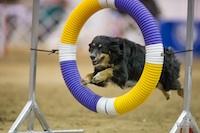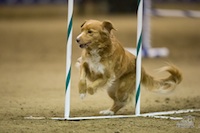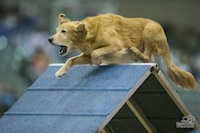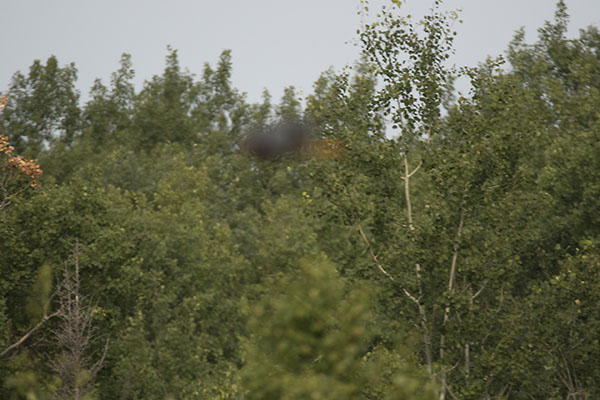I AM SMARTER THAN THE CAMERA, AND SO ARE YOU
Before we get to the “how” I want to spend a few moments on “why”.
I shoot the way I do because I am a control freak. I know that I am smarter than the camera. I know I can make better decisions than the camera about how to expose a scene and how to focus on the subject. Everything I do is done to maximize my control over how that image comes out. If you shoot in Auto Mode all the time, you are surrendering your control to the teeny-tiny brain of the camera and it is not that smart, especially when it comes to dog photography.
When you get stuck, you need to slow down, take a deep breath, and repeat after me:
“I am smarter than the camera.”
The nice thing about a camera is that, unlike a dog, you don’t have to worry about hurting its feelings. Feel free to cuss at it when you need to. However, just like with a dog (or maybe even more so), the mistakes are all on you. If your camera didn’t get the image you wanted, it’s because you weren’t giving it enough information to get that image. Unlike a dog, the camera’s reactions are 100% consistent. It is a machine and it CANNOT operate inconsistently, even if it appears that way to you. The way a camera behaves is entirely predictable. You have to learn your camera’s capabilities as well as its limitations. If a shot doesn’t work, don’t think, “If only I had a better camera/lens/dog, this photo would have been better.” Instead, look at the image and ask, “What could I have done differently? What more did I need to tell the camera to make this shot work?”
Photography is nothing if not complex, requiring multitasking on many levels. You have your subject to manage, light to analyze, plus the technical bits of choosing the right camera settings to capture the scene as you see it. And if your subject is something that moves, like a dog or a bird, you have to be ready for anything! Mastery of these things takes hours of practice until they become a function of muscle memory, rather than conscious thought. But I’m here to tell you that the hours pay off.
I used to be exactly where each of you are. I used to fumble with the dials and buttons on the camera, not sure which setting I needed to tweak and which ones to leave alone. But over time, these things have become second nature. I KNOW how my cameras will react in different situations. I know when the light is going to be a problem (almost always!). I KNOW when the camera is going to have trouble focusing on the right thing or focusing fast enough. And knowing how to predict these things means I can think it through and find ways to minimize the problems. Turn up the ISO in one situation, change the thing I’m focusing on in another, practice focusing quickly on one subject and then the other before there’s even a dog in the ring in a third.
Signing up for this class means you are ready to be a photography control freak too. AWESOME!
SETTING EXPECTATIONS
(or NOT EVERY PICTURE IS WORTH A THOUSAND WORDS)
No, this is not my expectations for you. This is about setting realistic expectations for yourself.
First of all, not every photograph is a keeper shot, let alone perfect. EVER! I still shoot my fair share of clunkers, but you’ll never see them. Well, for this class you'll see a few for illustration purposes, but normally, those images don’t get seen by anyone other than me.
Let me show you what I mean. This is a picture of a Green Heron. At least, that’s what it’s supposed to be. This is the best picture I got of it that day, and it flew by me at least 3 times. It happens, even to the professionals.
The beauty of digital is that we can get that instant feedback to see if we got the shot. If not, shoot it again. Shoot LOTS and learn how to edit. Do not think that becoming a better photographer requires every shot to turn out perfectly.
[Side note: I will use the word “edit” throughout this course to mean the simple task of deciding which image to keep and which ones to delete. I do not mean using Photoshop or other photo editors to enhance or change the image itself. For that, I will use the phrase “post-processing.” More on that in future lessons.]
For some perspective, here are my personal expectations for my three most common shooting situations.
1. When I am photographing an agility trial as the official photographer, I will shoot 5000-7000 photos in a day at a national-level event and keep (hopefully) ONE-THIRD to ONE-HALF of them. Usually it’s closer to a third. For a local trial, I’ll shoot on the order of 3K images and keep about half.
2. When I am out photographing birds, I will shoot 500-2000 pictures, depending on what I find. I am happy if I get 10-15 keepers. Yes, only 10-15!
3. When I am taking snapshots of family events or other casual opportunities, I use my iPhone. And I don't feel any guilt about it! My family sometimes wonders if I really am a professional photographer since they never see my “big camera.” These photos are for documentation, not art.
It also helps to disconnect emotionally from your photos by a little bit. Yes, you should love your work, but you have to develop a critical eye. If you are only keeping an image because of an emotional reaction to it and it doesn’t have the technical "chops" to back up that emotion, it is not a strong image. Likewise, if the image is tack sharp and perfectly exposed, but has no emotional component, it is also not a strong image.
Photography is a communication art and if your viewers get distracted by a photo that is out of focus (even just a little bit) or poorly composed, or can’t figure out what “story” you’re telling, they will not be able to hear the real message you are trying to convey. Editing, sometimes brutally and ruthlessly, will make your body of work much stronger.
Finally, slow down and think. I cannot emphasize this enough. Do not slam the camera up to your face and push the button willy-nilly and expect to get a good photo, let alone a great one. You don’t have the muscle memory yet to react to quickly changing circumstances. If you are frustrated taking photos of moving subjects, slow down and take photos of still objects. Learn your fundamentals on things that don’t move and master the basics. Then apply what you know to something that doesn’t stay in one place. Don’t obsess about the shots you didn’t get. Celebrate the shots you DID get!
We will spend a good portion of this class shooting things that aren’t your dog. You may even begin to wonder why it’s called Shoot the Dog! The biggest reason for this is that your dog is very unpredictable. Even a highly trained dog has moments of unpredictability. Most of you are not ready for unpredictability yet. You will practice on things that don’t move. When you get to the point of shooting things in motion, practice on things that are more consistent in their motion. Photographing dogs at play is hit-and-miss AT BEST. You don’t need that kind of frustration while you are learning so many other things about your camera.
There will be optional assignments most weeks that involve photographing a real dog. They will be related to the main assignment, but will have a higher degree of difficulty, simply because there's a new variable to deal with.
Once you feel comfortable with the basics, you will be able to apply them to taking pictures of your dog. There’s nothing particularly unique about dog photography, to be honest. It’s just applying good fundamental photography skills to a specific subject. We will cover those fundamentals in this class and begin the process of applying them to dogs by week 4 or so. However, it’s not until Level 2 that we’ll really start working on some of the specific challenges that may arise as you hone your skills at dog photography.
In her book Bird By Bird: Some Instructions on Writing and Life, writer Anne Lamott tells a story about her brother who was trying to write a report on birds for school. The report was due the next day, even though he’d had three months to work on it. As he sat at the kitchen table, surrounded by piles of paper and stacks of books on birds, he looked around almost in tears, not knowing even where to start. “Then my father sat down beside him, put his arm around my brother’s shoulder, and said, ‘Bird by bird, buddy. Just take it bird by bird.’”
We’re going to take it “bird by bird” in this class. We’ll learn the pieces and then start putting them together in different ways.
(I highly recommend the book. Anne Lamott is a brilliant writer, very funny and incredibly insightful.)
Lisa, a student from the June 2015 class session, wrote this:
It was really helpful to remind us that we are in charge of the image, not the camera. With all the tech advancements in cameras, it is way easy to think "well, I have this great camera, so I will let it take the pics for me" I.e. Auto. And then wonder why they still don't inspire the photographer.
I also am relieved to know that taking lots and lots of pics is not only ok, but probably essential to capture the best shots. It is good to know that professional photographers take bad pics too. I have a new rule now. It is ok to take a bad pic, but I don't have to share it. (Unless of course it is for a class or illustrative purposes.) So, my Facebook pics will have to start improving-at least for my "good" camera pics.



 Instructor: Amy Johnson
Instructor: Amy Johnson
